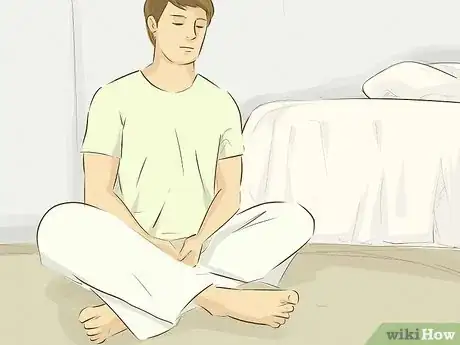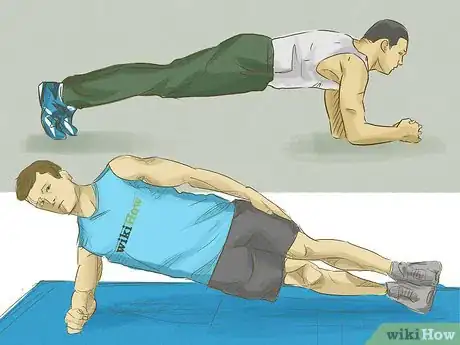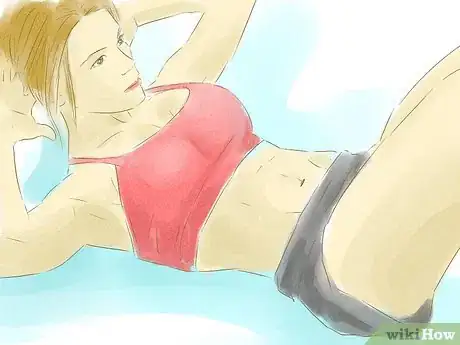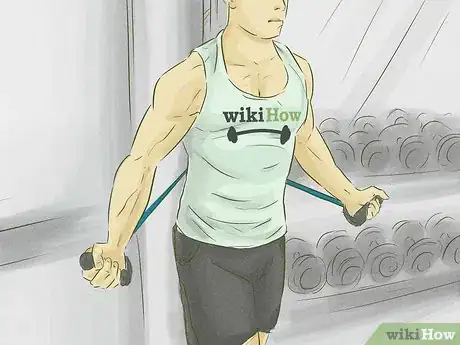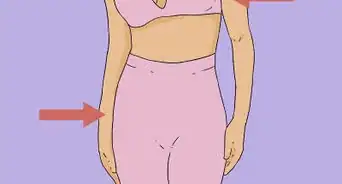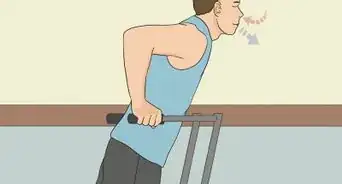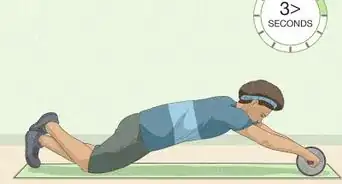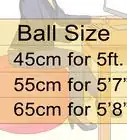This article was co-authored by Brendon Rearick. Brendon Rearick is a Personal Trainer, Strength Coach, Fitness Program Director, and co-founder of Certified Functional Strength Coach (CSFC), a fitness education company in the San Francisco Bay Area. With 17 years of experience in the fitness industry, Brendon specializes in strength and conditioning, and his company CSFC has certified over 3,000 trainers in over 20 countries. Brendon has worked as a Program Director for Mike Boyle Strength and Conditioning (MBSC) and earned his massage therapy license from the Cortiva Institute-Boston. Brendon holds a BS in Kinesiology from the University of Massachusetts Amherst.
There are 11 references cited in this article, which can be found at the bottom of the page.
This article has been viewed 287,144 times.
Many people focus on six-pack or washboard abs when working their abdominals and neglect the transverse abdominal muscle (TVA), which is underneath your rectus abdominis (the "six-pack" muscles). What they don't realize is that the six-pack will never be seen if the TVA is not also strong and well-developed. The TVA also acts as your body's natural "girdle," pulling your muscles in and helping draw in a "pooch" belly. In addition, they are important in protecting your back, stabilizing your pelvis, and improving your posture. Engage in exercises that focus on strengthening your TVA to improve the overall appearance of your midsection and support your overall core strength.[1]
Steps
Starting Basic TVA Exercises
-
1Locate your TVA. You can't work on a muscle without first knowing where it is. Activate the muscle by mentally locating it and doing basic movements that let you feel where the muscle is, making a brain-body connection. Picture the muscle like a corset around your stomach that draws in from 360 degrees to support your spine and pelvis.
- Try an exercise to physically engage the TVA. Lay on your back. Imagine pulling your belly button up into your spine. If needed, use your finger to gently give your body a physical cue. Don't hold your breath but continue breathing normally. You should be able to carry on a conversation. The muscle you are using is your TVA.[2]
- It is important you learn how to engage this muscle, because you may need to specifically focus on and use this muscle during some of the exercises or else you will not get the full benefit. When doing any of the exercises in this article, make sure you are thinking about your TVA and engaging it.
-
2Practice a "C" curve. This will help you recognize what it feels like to contract your abdominal muscles and isolate them. Sit up tall on the ground with your knees bent and your arms on top of your legs. Start to "scoop" out your belly, arching backward, drawing your stomach up near your spine. Roll back into the upright seated position. Repeat this 6 times.[3]Advertisement
-
3
-
4Do a hip bridge to isolate transverse abdominal muscles. This is a great exercise that will focus in on your TVA in a strengthening and stretching movement. Find a flat comfortable surface. Yoga mats can be great for this. Lie on your back with your knees bent, feet flat, and arms at your side. Contract your abdominals and use them to lift your hips 1 to 2 inches (2.5 to 5.1 cm) off the floor. The contraction will pull your hips up and in toward your ribcage. Controlling the movement with your abdominals, slowly lower your body back to the mat, starting with your upper back down to your tailbone.[6]
- This is very similar to a regular bridge, but slightly modified to work your TVA as opposed to your hamstrings and glutes. The main difference is that there is a very limited range of motion compared to the bridge. Without the mental focus on the TVA, the hams and glutes will do the job of lifting, so make sure you are concentrating on using your TVA.
- The key to this exercise is practice. You will begin to feel when you are isolating your TVA to pull your body up, rather than your back muscles. Start with 2 sets of 5 repetitions and work your way up to 3 sets as you become more accustomed to the exercise.
-
5Do planks for a full core workout.[7] Planks are great for a full body and ab workout that focuses on your TVA. Get into push-up position on the floor. Rest your weight on your forearms, letting your arms move into a 90 degree angle. Keep your elbows directly beneath your shoulders. Hold your body weight supported by your forearms for as long as you can. Keep your back straight — do not round or sag, as you could injure yourself.[8]
- Try a side plank to mix up your workout. Start out resting on your side, legs straight, feet stacked on top of each other. Prop your body up on your bottom arm, which should be bent. Contract your abs and use the movement to raise your hip off the ground, holding yourself up on your bottom arm. Your head, spine, and legs should be in a straight line.
-
6Do bicycle kicks to work your TVA. This is a great ab exercise, but especially for your TVA. Lie flat on your back on the mat. Assume table top position by bending your knees and hips at 90 degrees. Your feet should be off the floor, shins parallel to the ceiling. Place your hands behind your head and lift your shoulders off of the ground. Slowly begin to move your legs like you are pedaling a bike, alternating your right and left legs continually.
- Focus on your form, making sure you are stabilizing your core, keeping the pelvis from rotating, and holding the rib cage and pelvis in horizontal alignment. Try doing eight to 16 pedals.
- Repeat this in sets of 3 for a full ab exercise that really works your TVA.[9]
- To make the exercise more challenging, straighten your legs.
Adding Workout Equipment to TVA Exercises
-
1Use a stability ball to work your TVA muscles. Stability balls provide a challenge for your muscles and require balance and concentration. Start on your knees with your forearms on top of the stability ball. Draw your navel to your spine and exhale, simultaneously rolling your body forward with your forearms still on the ball. Your finish position should be a diagonal line from your knees to your head. Hold the position for three seconds, and then return to your starting point. Do this in 3 sets of 8 to 15 repetitions.[10]
- You can also do this with your lower body on the ball. Start with your shins on top of the stability ball with your palms on the floor. Raise your hips and then bend your knees toward your chest, rolling the ball forward. Hold this position for a couple seconds and then roll the ball back to the starting position.
-
2Add a medicine ball to your workout. Medicine balls come in a variety of weight increments, such as 1, 3, or 5 pounds. Choose a weight that challenges you without being too heavy, which can cause you to use poor form and lead to injury. Lie flat on your back with the medicine ball above your head in your hands. Lift your legs and hands about 6 inches (15 cm) off of the ground, contracting your TVA muscles. Bring your knees into your chest, lifting your shoulders off the ground and bringing the medicine ball toward your knees. Do not round your spine. Once the ball has reached your knees, return back to your starting position. This is 1 repetition. Try to do a few and work your way up.[11]
- You can also try doing V-ups. This follows a similar motion as the above exercise only you leave your legs straight and lift them to a 45 degree angle. Similarly, lift your upper body until your legs and arms form a "V" shape, again making sure the spine is straight and your TVA muscles are fully engaged and contracted. The medicine ball with help with resistance.[12]
-
3Do full extension sit-ups with a medicine ball. Lie on your back flat on the mat, holding your medicine ball above your head with both hands. Lift your upper body off of the mat toward your knees. Keep your spine straight — don't round forward. Once you've touched your knees, lower yourself back to the ground. This is 1 rep.[13]
- Make sure to keep your abs tight through the entire exercise to keep them engaged and protect your spine.
-
4Try planks with medicine balls. This is an advanced exercise so it should only be done by someone who has mastered the regular plank and spent some time building up their muscles, or else it can cause a strain. Place the medicine ball down by your feet and get into a plank position, as described above. Put your left foot on the medicine ball and stabilize your abs by tightening them. Once you are balanced, pull your right knee toward toward your chest and then lower it back to the medicine ball. Do this until exhaustion and then switch to the other side.[14]
- Make sure your core is always engaged and that your spine is straight. Do not round the spine, twist, or allow yourself to sag. Your body needs to be straight or you risk injuring your spine.
- You may want to begin by placing the ball under your knees and improve your balance and strength before performing the exercise with the ball under your feet. If your feet slip off the ball, you may twist your spine and injure your back.
-
5Use an exercise band to work your TVA. Exercise bands are a great way to work out muscles in a very natural way. They emphasize resistance and natural body weight exercises as opposed to the difficulties of weights. Add the band to traditional TVA exercises to enhance and make them more difficult.
- Attach the band to a high, stable structure (like a door frame). Hold the end of the band in your hands as you stand on your knees. Bend forward, holding the band, until your face touches the ground. Slowly return back up to the kneeling position.[15]
- Flip this exercise. Anchor the band on a low support (like around the leg of a very heavy sofa that won't slide). Lay on your back with your knees bent at a right angle. Hook the band with the tops of your feet, then scoot back until you feel tension in the band. Contract your abs and pull your TVA in toward your spine. Use your abs to draw your knees toward your shoulders, keeping your spine straight. Hold, then return to the starting position. Do 12 to 15 reps.[16]
Expert Q&A
Did you know you can get expert answers for this article?
Unlock expert answers by supporting wikiHow
-
QuestionHow can I work my transversus abdominis?
 Brendon RearickBrendon Rearick is a Personal Trainer, Strength Coach, Fitness Program Director, and co-founder of Certified Functional Strength Coach (CSFC), a fitness education company in the San Francisco Bay Area. With 17 years of experience in the fitness industry, Brendon specializes in strength and conditioning, and his company CSFC has certified over 3,000 trainers in over 20 countries. Brendon has worked as a Program Director for Mike Boyle Strength and Conditioning (MBSC) and earned his massage therapy license from the Cortiva Institute-Boston. Brendon holds a BS in Kinesiology from the University of Massachusetts Amherst.
Brendon RearickBrendon Rearick is a Personal Trainer, Strength Coach, Fitness Program Director, and co-founder of Certified Functional Strength Coach (CSFC), a fitness education company in the San Francisco Bay Area. With 17 years of experience in the fitness industry, Brendon specializes in strength and conditioning, and his company CSFC has certified over 3,000 trainers in over 20 countries. Brendon has worked as a Program Director for Mike Boyle Strength and Conditioning (MBSC) and earned his massage therapy license from the Cortiva Institute-Boston. Brendon holds a BS in Kinesiology from the University of Massachusetts Amherst.
Personal Trainer & Strength Coach I would recommend you start by practicing proper diaphragmatic breathing. Breathe in slowly through your nose until your stomach expands, then breathe out through your mouth. The transversus abdominis is connected to many different muscle groups, so doing proper breathing will be the one of the best ways to strengthen it.
I would recommend you start by practicing proper diaphragmatic breathing. Breathe in slowly through your nose until your stomach expands, then breathe out through your mouth. The transversus abdominis is connected to many different muscle groups, so doing proper breathing will be the one of the best ways to strengthen it.
References
- ↑ https://bamboocorefitness.com/the-transverse-abdominis-the-spanx-of-your-abdominal-muscles/
- ↑ http://www.theptdc.com/2015/01/the-best-core-strengthening-exercises-to-a-healthier-spine/
- ↑ http://www.healthline.com/health/fitness-exercise/transverse-abdominis-exercises#1
- ↑ Brendon Rearick. Personal Trainer & Strength Coach. Expert Interview. 12 August 2020.
- ↑ Brendon Rearick. Personal Trainer & Strength Coach. Expert Interview. 12 August 2020.
- ↑ http://www.healthline.com/health/fitness-exercise/transverse-abdominis-exercises#3
- ↑ Brendon Rearick. Personal Trainer & Strength Coach. Expert Interview. 30 July 2020.
- ↑ http://www.mensfitness.com/weight-loss/burn-fat-fast/how-to-do-a-plank-a-single-move-for-stronger-abs
- ↑ http://www.healthline.com/health/fitness-exercise/transverse-abdominis-exercises#1
- ↑ http://livehealthy.chron.com/tips-strengthen-tva-muscles-smaller-waistline-9229.html
- ↑ https://caloriebee.com/workout-routines/How-to-Exercise-Transverse-Abdominal-Muscles
- ↑ http://healthyliving.azcentral.com/exercises-medicine-ball-tighten-tummy-1631.html
- ↑ https://caloriebee.com/workout-routines/How-to-Exercise-Transverse-Abdominal-Muscles
- ↑ https://caloriebee.com/workout-routines/How-to-Exercise-Transverse-Abdominal-Muscles
- ↑ http://greatist.com/fitness/resistance-band-exercises
- ↑ http://greatist.com/fitness/resistance-band-exercises
About This Article
Your transverse abdominals are located underneath your main six-pack muscles, and exercising them helps to refine your abs. One exercise you can do to grow your transverse abdominals is sucking in your stomach. First, lie on your back with your knees bent, then slowly breathe in to tense your abs. Hold the position for 5 seconds and repeat. You can also do hip bridges. Lie on your back with your knees bent. Then, lift your hips a couple of inches off the floor while contracting your abs. Start with 2 sets of 5 repetitions and work your way up to 3 sets as you get used to it. For a full-core workout that targets your transverse abs, do regular planks and one-armed side planks. Hold them for as long as you can. For more tips from our Personal Training co-author, including how to work your transverse abdominals with an exercise ball, read on!


